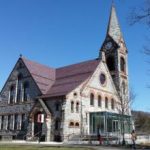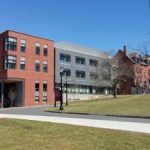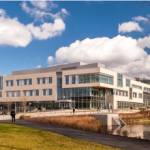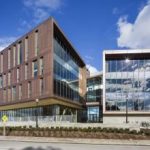Get the inside stories of the renovated Old Chapel, South College addition, Integrative Learning Center, and brand new Design Building! Ludmilla Pavlova, Senior Campus Planner, will lead a walking tour on Thursday, April 13th. The event is free and open to the public. RSVP here! For more information, visit https://websites.umass.edu/talkingtruth/.
Tour Schedule
4:00 – 4:10 PM – Meet in W.E.B. DuBois Library lobby
4:10 – 4:25 PM – Old Chapel
 New renovations to the iconic structure include a new entry pavilion, double height entry lobby with an elevator, multipurpose space, and the unveiling of the existing rose window on the north elevation viewed from the Great Hall for the first time since 1936.
New renovations to the iconic structure include a new entry pavilion, double height entry lobby with an elevator, multipurpose space, and the unveiling of the existing rose window on the north elevation viewed from the Great Hall for the first time since 1936.
4:25 – 4:40 PM – South College Academic Facility
 From 2015-2017, South College underwent a major renovation, restoration, and addition project. The existing structure was restored, and all major building systems were upgraded to meet code. A four-story, 60,000 S.F. addition was constructed on the west side of the building, housing common areas, faculty offices, and classrooms with state-of-the-art audiovisual systems. Together, The renovation and addition now serve as the primary home of the College of Humanities and Fine Arts, including the departments of English, Philosophy, Art History, and Women, Gender & Sexual Studies.
From 2015-2017, South College underwent a major renovation, restoration, and addition project. The existing structure was restored, and all major building systems were upgraded to meet code. A four-story, 60,000 S.F. addition was constructed on the west side of the building, housing common areas, faculty offices, and classrooms with state-of-the-art audiovisual systems. Together, The renovation and addition now serve as the primary home of the College of Humanities and Fine Arts, including the departments of English, Philosophy, Art History, and Women, Gender & Sexual Studies.
4:40 – 4:50 PM – Walk
4:50 – 5:05 PM – Integrative Learning Center
 The four-story structure located in the center of campus provides 2,000 seats of new classroom space as well as space for several academic departments including Communication, Journalism, Linguistics, and Film Studies. Classrooms were designed to be fully equipped with newly developing educational technologies in addition to a number of the other digitally enabled learning spaces.
The four-story structure located in the center of campus provides 2,000 seats of new classroom space as well as space for several academic departments including Communication, Journalism, Linguistics, and Film Studies. Classrooms were designed to be fully equipped with newly developing educational technologies in addition to a number of the other digitally enabled learning spaces.
5:05 – 5:15 PM – Walk
5:15 – 5:30 PM – Design Building
 The Design Building is located on the southern portion of parking Lot 62 north of the Studio Arts Building and houses the Architecture, Landscape Architecture & Regional Planning, and Building & Construction Technology academic programs. The building is intended to showcase integrated design through a stacked courtyard surrounded by studios, classrooms, workshops, and offices.
The Design Building is located on the southern portion of parking Lot 62 north of the Studio Arts Building and houses the Architecture, Landscape Architecture & Regional Planning, and Building & Construction Technology academic programs. The building is intended to showcase integrated design through a stacked courtyard surrounded by studios, classrooms, workshops, and offices.
The UMass Amherst Libraries host a series of interactive climate change events. Now in its second year, the series is organized by Talking Truth: Finding Your Voice Around the Climate Crisis, a collaborative community comprised of UMass Amherst students, faculty, and staff working together to integrate the intellectual, emotional and spiritual dimensions of climate change. The theme of the spring 2017 series is “Living and Working with Purpose in a Time of Climate Disruption.








